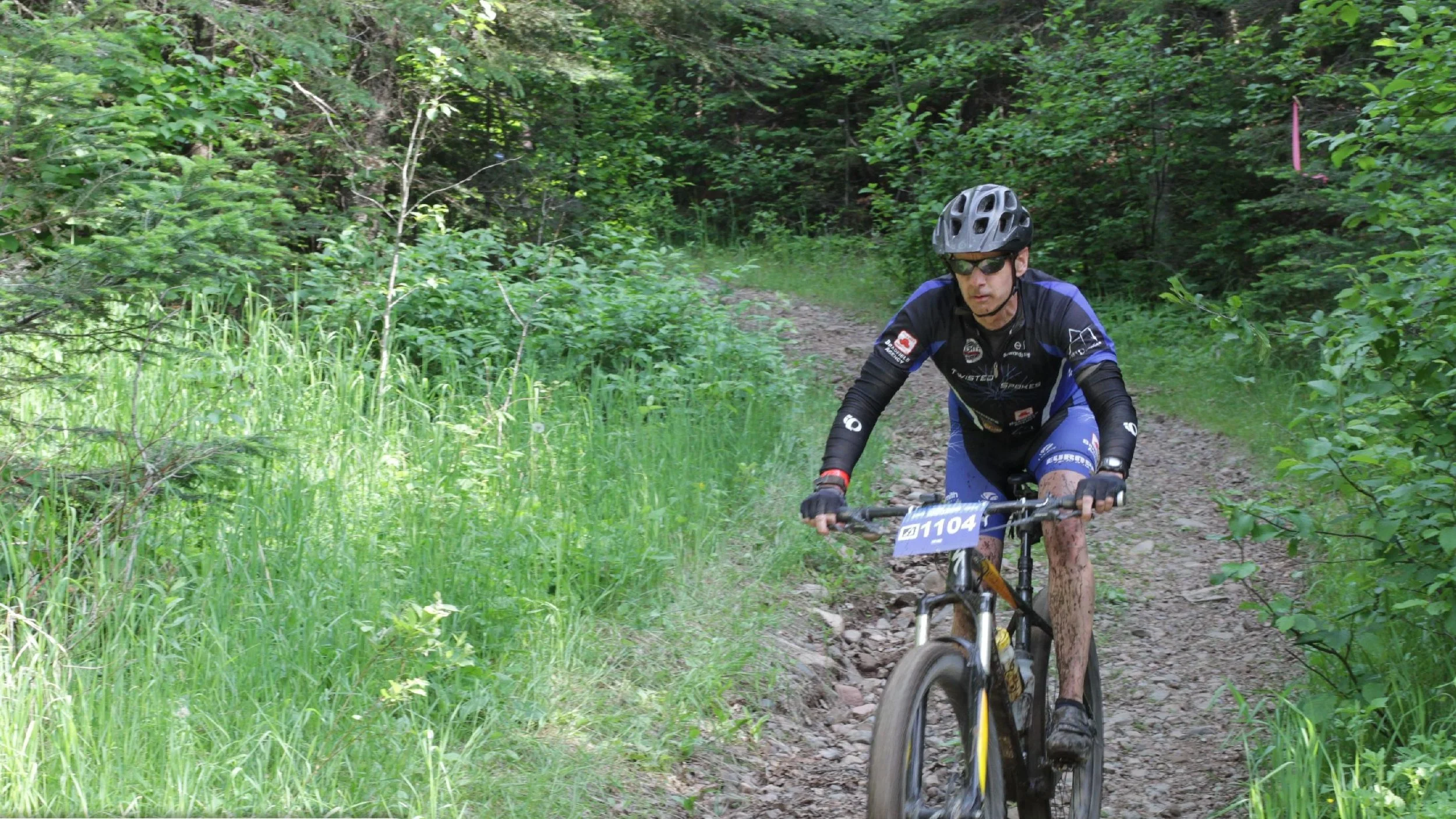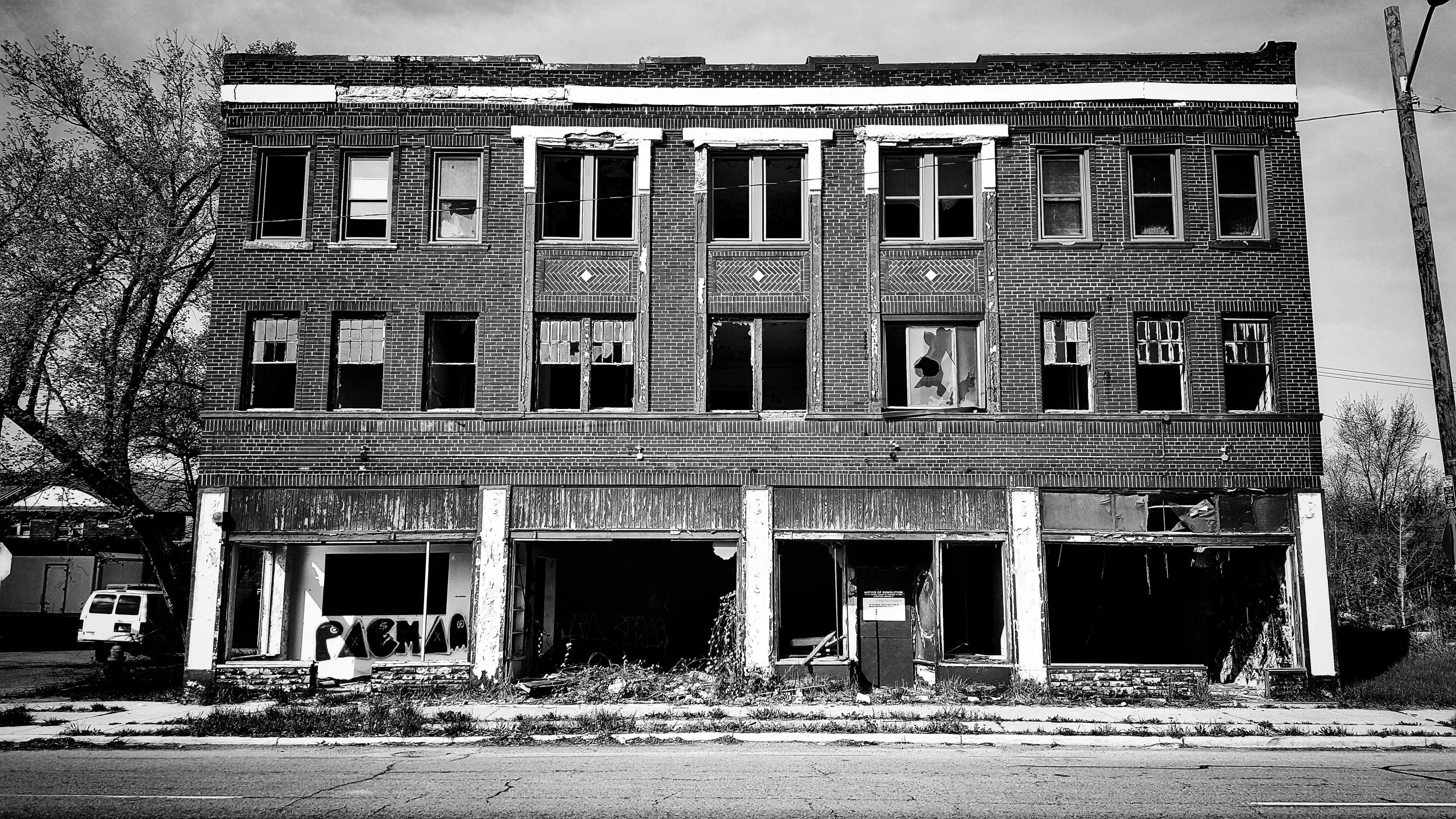black side | white side
“... more white people looking at the wall.” The young man watched us for a moment, and then went back to playing basketball.
We looked at the wall. It was off to the side of the park. There was no paved approach and the grass was getting a little long, but we walked right up to it, touched it, marveled at it, even looked over the top of it, which, when I think about it now, was rude and intrusive to the people on the other side.
8 Mile Wall, or Detroit’s Wailing Wall, has been here since 1941. It’s a foot wide, six or so feet high and a half a mile long. Mostly it runs through backyards, but here it marks the edge of a neighborhood park.
The symbolism of walls is often used to describe barriers between people, and here is a real one. Not figurative, not symbolic, but an actual concrete-block wall constructed for the purpose of dividing areas of investment from areas where public loans would not be available for development. It was intended to be a hard boundary between black and white.
Seventy-seven years later the neighborhoods are now mostly black on both sides of the wall, and white people like us come from the outside to look at it.
The young man who said “more white people looking at the wall” approached us as we were leaving. He was challenging, but not hostile; polite, but not overly-friendly. He wanted to know why we were there in his neighborhood.
I try to think about how this looks to him - all these white people coming to look at the wall - and I try to understand his point of view, but very quickly realize how difficult that is. There’s a racial difference between us, but also a geographic one and a cultural one. My life in a quiet, Iowa college town gives me a completely different perspective than he has here in Detroit.
I know nothing about him except what I see right here: he’s a young man - maybe late teens, maybe early twenties - he’s black, has a bicycle, plays basketball and hangs out in a public park. Anything beyond that is conjecture or assumption. I don’t know where he lives or who he lives with or what he does during the rest of the day or night. I don’t know if he goes to school, has a job, a partner, or kids of his own.
What I know comes from what I see and what I read into what he says. “More white people coming to look at the wall”. Is it amusement, frustration, confusion or outright anger which drives that statement? The wall has been here longer than he has - a seemingly permanent piece of the public landscape. It’s a predominantly black neighborhood and apparently carloads of white people show up with regularity. They look at the wall and then they leave again.
I try to think of a parallel in my world, but I really can’t, so I have to create a scenario in my mind. In my predominantly white neighborhood, there’s a school a block from my house with a flagpole out front. What if carloads of black people regularly showed up to troop over to the flagpole, looked at it for a bit, then got back into their cars and drove away? It would be weird. I would probably find myself amused, frustrated, confused and maybe even angry … all these people creating extra traffic on my street, extra commotion over at the school. They’re outsiders, and neighborhoods are safer, more orderly, more comfortable, and quieter without outsiders coming in and looking around.
My manufactured scenario falls apart, of course, because there is no historical significance to that flagpole, but there is to this wall. It is significant to people who look like this young man and significant to people who look like me because the wall was engineered to divide us. It was built by people who look like me for the purpose of keeping people who look like him in their place. People who look like me have, historically, been good at dominating, exploiting, and oppressing people who look like him and this wall is a part of that tradition.
People come to look at the wall, but it really isn’t set up as a tourist attraction. This park has no historical marker or descriptive plaque to assist interpretation. There isn’t even a parking lot - just a cul de sac where the street dead-ends.
The wall sits there quietly off to the side, away from the basketball court and the picnic shelter. It might even be the kind of thing that you wouldn’t notice after a while. At the edge of the park it wanders off into the neighborhoods, separating these backyards from those.
The wall is a relic of a disgraceful policy and it was sobering to see it. White privilege can be a confusing concept for some people - I admit that it is for me. I go through my life making my best decisions and taking opportunities as they come, without much thought to issues of race … without really considering who else has these same opportunities and who doesn’t. But the loan program that led to the building of this wall was a perfect example of how a white privilege is created: the whites on one side of the wall were eligible for loans to improve their property, the blacks on the other side were not.
As a white man, it’s not always easy to face the subject of racism. I can end up feeling accused and defensive. I certainly don’t want to be lumped into a category of white men that includes Christopher Cantwell, Jason Kessler or David Duke. I’m trying to understand white privilege and it’s not my intention or my desire to treat people differently because of their color. It's not my desire or my intention to hate anyone, or oppress anyone, or to live in a way that creates a hassle for anyone of any color. In my heart I want everyone to succeed and there isn’t a racial qualifier on that statement.
But before I give myself a full-pass on racism, I have to consider this little piece of human nature: that the human animal generally finds comfort in a community of sameness, and tension among those who are different. If that is a definition of racism, then I’m probably racist, and to one extent or another, you probably are, too.
How racist am I? I think about us white people peeking over the wall. If there were a similar wall in my backyard and a black face appeared over the top and looked around at my garden, my patio, my barbecue, how would I feel?
If I’m going to be honest . . .
maybe I won’t answer that just now. Maybe I’ll think about it for a while and get back to you.
The side of the wall facing the park has been painted with scenes of urban life, both ideal and actual, and with depictions of events from the civil rights movement. From a distance it looked like there were holes in the wall - right there by the painting of Rosa Parks’ bus. It looked like light was coming through. I went to put my eye up to one and saw myself looking back. It wasn’t a hole at all, but a piece of mirror glass integrated into the painting. A bit of brilliance from the artist that both asks, “what are you looking at?” and states, “we’re people just like you.”
. . .
There is an unfairness in our country and in our culture that the people who look like this young man here in the park have been battling to overcome for almost three hundred years. The culture and the country have always been dominated by people who look like me, so “we” have to be part of the solution.
And that’s where more frustration comes in. I have no idea where to begin. How can I be a part of the solution when I don’t even understand my role in the problem? Some might say we could begin simply by talking to each other, but I can’t even seem to manage that very well.
The young man from the basketball court asked others in our group why we were looking at the wall. And then he asked me about the photos he saw me shooting with my phone. “What are you going to do with those?”, he asked. I didn’t have a good answer because I didn’t yet know, so I fumbled around and said something about wanting to remember what I saw.
It was an awkward exchange. I wish I had not been feeling rushed to keep up with my group as we got back into our cars to leave. Maybe I could have talked to him more. I wish I had asked him to explain how he felt about us being there. I wish I had asked him who’s wall it is, white’s or black’s or both? I wish I could have asked him who’s problem racism is, his or mine, theirs or ours? I wonder if he, too, was left unsatisfied with our conversation and felt like we could have gone deeper and that we wasted an opportunity to gain a little insight into each other.
I appreciate that the young man was forward enough to engage us. I appreciate that he was direct and got right to the point and didn’t mess around with small talk about the weather. I hope he keeps doing it with the other white people who will come after us.
I hope the young man’s curiosity about why we were there is genuine. I hope it is something that he thinks about and even if we didn’t articulate it very well, I hope he realizes that those of us who come to look at the wall are among those trying to understand who we are and who he is and how we can improve the ways we live in communities with each other.
And, I hope he understands that we white people need to see the wall. While the artwork has turned it into a celebration of civil rights, the structure itself represents something ugly about human nature, and ugly about us, and we need to see it.







